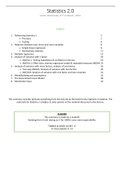Samenvatting
Summary Statistics/Statistiek 2 (VU)
- Instelling
- Vrije Universiteit Amsterdam (VU)
Summary of all lectures from the Stats 2 course at the VU, psychology year 2. Includes lecture notes, examples and all chapters from Agresti & Finlay that are required for this course.
[Meer zien]





